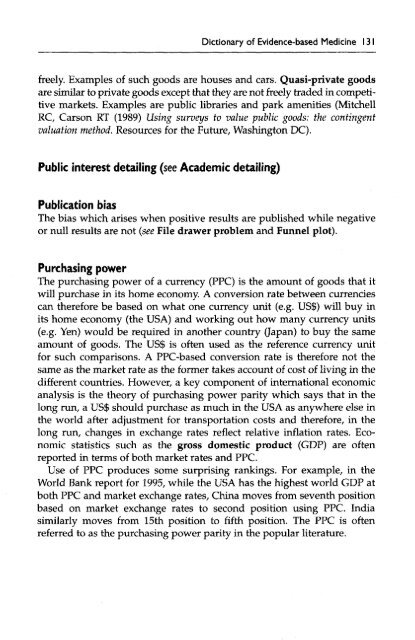Dictionary of Evidence-based Medicine.pdf
Dictionary of Evidence-based Medicine.pdf
Dictionary of Evidence-based Medicine.pdf
You also want an ePaper? Increase the reach of your titles
YUMPU automatically turns print PDFs into web optimized ePapers that Google loves.
<strong>Dictionary</strong> <strong>of</strong> <strong>Evidence</strong>-<strong>based</strong> <strong>Medicine</strong> 131<br />
freely. Examples <strong>of</strong> such goods are houses and cars. Quasi-private goods<br />
are similar to private goods except that they are not freely traded in competitive<br />
markets. Examples are public libraries and park amenities (Mitchell<br />
RC, Carson RT (1989) Using surveys to value public goods: the contingent<br />
valuation method. Resources for the Future, Washington DC).<br />
Public interest detailing (see Academic detailing)<br />
Publication bias<br />
The bias which arises when positive results are published while negative<br />
or null results are not (see File drawer problem and Funnel plot).<br />
Purchasing power<br />
The purchasing power <strong>of</strong> a currency (PPC) is the amount <strong>of</strong> goods that it<br />
will purchase in its home economy. A conversion rate between currencies<br />
can therefore be <strong>based</strong> on what one currency unit (e.g. US$) will buy in<br />
its home economy (the USA) and working out how many currency units<br />
(e.g. Yen) would be required in another country (Japan) to buy the same<br />
amount <strong>of</strong> goods. The US$ is <strong>of</strong>ten used as the reference currency unit<br />
for such comparisons. A PPC-<strong>based</strong> conversion rate is therefore not the<br />
same as the market rate as the former takes account <strong>of</strong> cost <strong>of</strong> living in the<br />
different countries. However, a key component <strong>of</strong> international economic<br />
analysis is the theory <strong>of</strong> purchasing power parity which says that in the<br />
long run, a US$ should purchase as much in the USA as anywhere else in<br />
the world after adjustment for transportation costs and therefore, in the<br />
long run, changes in exchange rates reflect relative inflation rates. Economic<br />
statistics such as the gross domestic product (GDP) are <strong>of</strong>ten<br />
reported in terms <strong>of</strong> both market rates and PPC.<br />
Use <strong>of</strong> PPC produces some surprising rankings. For example, in the<br />
World Bank report for 1995, while the USA has the highest world GDP at<br />
both PPC and market exchange rates, China moves from seventh position<br />
<strong>based</strong> on market exchange rates to second position using PPC. India<br />
similarly moves from 15th position to fifth position. The PPC is <strong>of</strong>ten<br />
referred to as the purchasing power parity in the popular literature.










